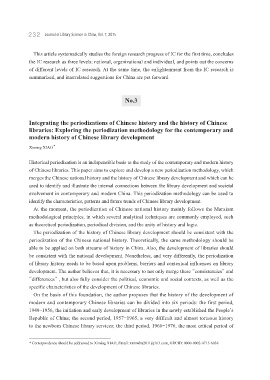Page 233 - JOURNAL OF LIBRARY SCIENCE IN CHINA 2015 Vol. 41
P. 233
232 Journal of Library Science in China, Vol. 7, 2015
This article systematically studies the foreign research progress of IC for the first time, concludes
the IC research as three levels: national, organizational and individual, and points out the concerns
of different levels of IC research. At the same time, the enlightenment from the IC research is
summarized, and interrelated suggestions for China are put forward.
No.3
Integrating the periodizations of Chinese history and the history of Chinese
libraries: Exploring the periodization methodology for the contemporary and
modern history of Chinese library development
Ximing XIAO 1 ∗
Historical periodization is an indispensible basis to the study of the contemporary and modern history
of Chinese libraries. This paper aims to explore and develop a new periodization methodology, which
merges the Chinese national history and the history of Chinese library development and which can be
used to identify and illustrate the internal connections between the library development and societal
evolvement in contemporary and modern China. This periodization methodology can be used to
identify the characteristics, patterns and future trends of Chinese library development.
At the moment, the periodization of Chinese national history mainly follows the Marxism
methodological principles, in which several analytical techniques are commonly employed, such
as theoretical periodization, periodical division, and the unity of history and logic.
The periodization of the history of Chinese library development should be consistent with the
periodization of the Chinese national history. Theoretically, the same methodology should be
able to be applied on both streams of history in China. Also, the development of libraries should
be consistent with the national development. Nonetheless, and very differently, the periodization
of library history needs to be based upon problems, barriers and contextual influences on library
development. The author believes that, it is necessary to not only merge these “consistencies” and
“differences”, but also fully consider the political, economic and social contexts, as well as the
specific characteristics of the development of Chinese libraries.
On the basis of this foundation, the author proposes that the history of the development of
modern and contemporary Chinese libraries can be divided into six periods: the first period,
1949-1956, the initiation and early development of libraries in the newly established the People’s
Republic of China; the second period, 1957-1965, a very difficult and almost tortuous history
to the newborn Chinese library services; the third period, 1966-1976, the most critical period of
* Correspondence should be addressed to Ximing XIAO, Email: xxmwhu2011@163.com, ORCID: 0000-0002-0715-6038

